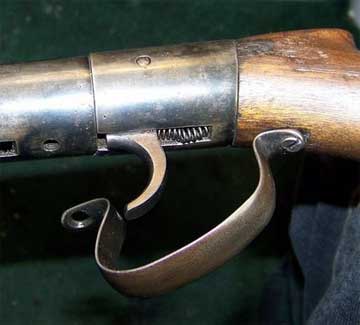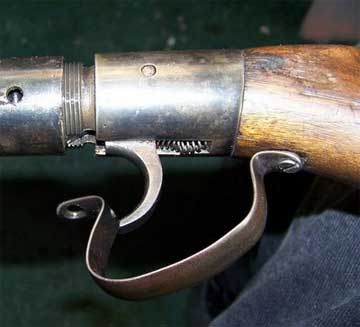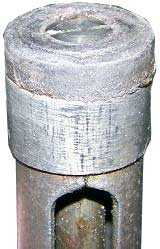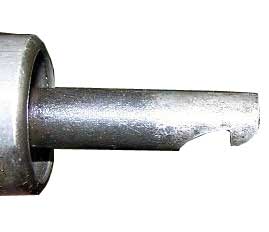by B.B. Pelletier
Guest blogger
Vince got another gun from Wacky Wayne, but this vintage rifle is one that most airgunners probably won’t see unless they go to an airgun show. In fact, most of you have probably never heard of this air rifle. Here’s a chance to see it before and after Vince does his magic.
If you’d like to write a guest post for this blog, please email me.
Bloggers must be proficient in the simple html that Blogger software uses, know how to take clear photos and size them for the internet (if their post requires them) and they must use proper English. We will edit each submission, but we won’t work on any submission that contains gross misspellings and/or grammatical errors.
by Vince
Do Tell! That’s pretty much what Wayne grunted to me as he informed me of his latest win on gunbroker–a German-made Tell air rifle in .22 caliber. “Ugh. I buy Tell. You do Tell,” or something to that effect. He wanted to send it to me to give it a once-over, a check-out and do anything else necessary to make it into a world-class FT rifle. Or whack soda cans at 10 paces. Whatever.
A few days after he wins this thing, it shows up at my door. As I first set eyes on it, it becomes apparent that this thing is not a typical airgun, or at least not a typical airgun as might have been built in the past 80 years.

The Tell is a bit unusual.
There’s no forestock at all, the cocking link is totally exposed and the sights are not adjustable for elevation. Since they’re both dovetail-mounted, they can be drifted for windage. There’s a crude trigger adjustment that looks factory–an external screw that threads through the front of the triggerguard and controls the engagement of the direct-sear trigger.

Simple, but I don’t like this sort of adjustment on a direct sear.
The barrel and breechblock are machined out of a single piece of steel, and the rear 40 percent or so has a classic octagonal shape to it. All in all, something about it very much reminds me of how an early .22 rimfire rifle might have been built. I have no idea of the date, but another early German airgun I worked on for Wayne (a Haenel Mod 1 DRP, ~1920s) looked pretty normal. So, I’m guessing this one might be earlier than that. The makers of this rifle certainly had a preference for machining over stamping, and it makes me wonder what it must have cost new.

Now, THAT’S a cocking link!
As I start looking it over, I notice a couple of problems right off the bat: the lockup feels loose and the barrel has a definite upward lift to it. Velocity is in the low 400 with Gamo Match pellets, which I imagine is probably pretty normal for it. With the questionable lockup, I didn’t even try accuracy at this point; rather, I just dug right into the guts of it.
The rifle comes apart in an interesting way. A little unusual but not unheard of. Wayne’s old Haenel and my R10 are constructed like this. There are no pins to knock out; once the proper screw is removed, the endcap with the trigger assembly simply unscrews from the rest of the action.

Remove front triggerguard bolt…

…and unscrew!
At this point, it disassembles pretty much like any standard spring gun. The inner parts are in pretty good shape (hope MY inner parts are in as good a shape at that age!). The leather seal on the piston hasn’t visibly deteriorated, and the catch for the direct-sear trigger looks pretty good.

Leather piston seal is good enough to reuse.

No serious wear on the direct-sear trigger.
This is something I was particularly concerned about since the trigger felt “iffy” when I test-fired the gun. By iffy, I mean that it wouldn’t always hold. I don’t trust iffy when it comes to direct-sear triggers (well, any trigger for that matter).
Vince will tell you more about Wayne’s Tell in the next part.
Wow, you guys are getting some strange guns. It's amazing how you can figure out how these things come apart without damaging them without a factory diagram. Also amazing is the leather seal being in such good shape after so many years. I don't know if you are hinting at quality construction or that it didn't get used much. In either case, that leather still held up awfully well. Anxious to see what else is in there.
-C
Vince,
We know that BSA started making modern air rifles in 1905 with their "H The Lincoln" model designed by Lincoln Jefferies. This Tell is probably from the teens or '20s, as it closely resembles those earlier BSA springers.
Everything is overbuilt and under-stressed. That's why these oldies last so long.
I can't wait to see what you find!
B.B.
Goodmorning B.B.
This blog is not appearing when I open the PA web site and click on blog. I got to it through my e-mail.
Vince,
Wow, this looks like a very interesting gun. Wish I could pick this it up and really look at it!
Mr B.
Nice project gun. I'll be following this one closely. The piston latch looks to be in great shape. As you mentioned, this can be the achilles heal of vintage springers. If the hook is worn or rounded, there's little that can be done by your average basement hack (ie, me.) It would need to be re-profiled and re-hardened.
Another thing to watch for in these oldies is over-cocking. With a direct-sear trigger, you can actually see the trigger move as it latches. On some guns, like the Belgian Hyscores, the barrel can rotate a little beyond full cock, which makes the front part of the latch hook press down on the sear, reducing engagement, or in some extreme cases, not allowing engagement at all. There is a "sweet spot" of full sear engagement, so you have to pay attention to how it feels when you cock it, and also watch the trigger. Once you get the feel, its second nature, but its something to be aware of if you're used to cocking modern spring rifles.
Jim in PGH
BB, the construction of this thing has many similarities to an old BSA underlever that Wayne had me do (I'll write that one up sometime if I have enough pictures). The BSA was from around 1913 if I'm not mistaken, and it was better made. Beautiful rifle. Broke my heart to send it back to him!
Mr. B,
I'm not having any issues getting to the blog from Pyramyd Air's website.
Is anyone else having an issue?
Edith
Vince,
Nice Write up..
She sure looks nice on the wall..
One of these days she'll be setup in the shooting museum.. ready to sight in on a 500 yard target:)..
Well maybe 50 foot target..
Yeah, the old Tell and BSAs are really fine classics that turn me on too.. I'll send one back to you, Vince, if you miss her that much!!
Wacky Wayne
Ashland Air Rifle Range
Edith,
The PA Blog link seems to work fine from Ashland Oregon.
Wayne
Edith(Mrs.B.B.),
Blogger is working fine now, go figure. It's above my pay grade.
Mr B.
Vince and B.B.
At first this gun immediately reminded me of the old H&A "bottom banger" muzzle loader.
It was VERY plain, hammer was on the bottom, and the trigger guard was also the hammer spring.
A lot of similarity in appearance.
twotalon
twotalon,
You made a statement the other day about throwing heavy lead out of your Talon and said thay you're using a Condor tank, hammer, and spring. A couple of questions please–how heavy, what caliber, at what fps, barrel length, and top hat setting. Thanks much!
Mr B.
It's a .22 18". Only the Condor weight and tank were added.
Kodiaks peak at 965 fps with 180 bar fill. Tophat left at factory setting…whatever it is.
Velocity curve a fairly nice bell with a 35fps spread. Average velocity just under 950 fps. Shot count on the curve is 32 or 33 shots.
Noise is not noticeably different from standard power plant setup.
Curve is running with PW at 5-8. Increasing the PW to 6 starts out at max velocity (still 965 fps) then runs downhill with reduced shot count. Higher PW setting only increases noise and eats up air.
twotalon
That looks like a really fun project! I can tell this is going to be a really fun new hobby! So many different facets to get involved in.
twotalon,
Thank you sir.
Fused,
Welcome and yes this is a fun hobby, and interesting past time or a sick obsession depending on who you're talking with.
Vince,
Good luck getting a competitive field target rifle out of this one.
BG_Farmer, I left out the Winchester 70 because while big on the name recognition as the "rifleman's rifle" it sounds with its controlled round feeding to basically be a derivative of the Mauser 98. The same reasoning applies to the Remington 700 which seems to be a Mauser derivative without the controlled round feeding.
The Mannlicher-Schoenauer does sound very interesting. I feel bad not including more of the great European/German tradition of rifle-making. Some sources indicate that the Kentucky rifle was really developed by German riflesmiths who immigrated to America.
The huge variety of makes is one reservation I have against including the Kentucky rifle but maybe it could be defined in terms of the extra long barrel and perhaps improved quality of rifling. Thanks Mr. B for the American Rifleman reference; I'll take a look.
Chuck, yes I decided that the AK-47 was the more successful realization of the assault rifle principle. Besides, the M-16 even taken by itself has the fatal flaws of unrealiability and poor lethality. Everyone except the U.S. Army seems to have realized that the 5.56 cartridge is insufficient. However, the M-16 is very influential, at least in terms of ergonomics, perhaps the most successful failure I can think of.
As a final comment on archery, one would suppose that the huge draw weight of the longbow is related to range and force. However, I was stunned to learn that the design with the greatest range is not the longbow at all but the recurve in use by the East and Native American peoples. The design is intrinsically more efficient. Calculations suggest that the longbow's maximum range was about a quarter mile while there are numbers of accounts of recurves reaching over 500 yards. Longbows are supposed to be smoother shooting but also more susceptible to hand shock. Crossbows outranged both.
Matt61
Kiwi90,
Thanks for the info on the 1897 shotgun. It's definitely in as is the the Benjamin Sheridan airguns.
Chuck, ha ha, the blunderbuss is a good idea. It's definitely go the historical significance, but it doesn't look to be a very capable weapon. Was it a shotgun with that muzzle design?
Anonymous, yes I've heard of the lamentations about how the English were not practicing their longbow skills sufficiently. You hear the same thing about the American militia who could not be induced to train after the Revolutionary War.
Matt61
Matt61,
For the "Gun that Won the West" use the Winchester Model 1873 or 1897.
Vince,
Is that a coil or two of spring I spy in the little hole in the second unscrew picture? How do you control the spring tension while dis or assembling the gun?
Mr B.
Matt61,
A Remington 700 is an original design and cannot be said to be based on the Mauser any more than other front locking bolt actions. It was designed to be made from round bar or tubing.
The Asian recurve bows were often composite. They used bone on the back of the bow and some sort of hide on the front because these materials withstood compression and tension better than wood. I believe they were also more resistant to set, so they could be strung with more tension. This meant the arrow got more force near the end of the bowstring's travel, even if the maximum draw weight had been no higher than an Englishman's long bow.
Anonymous and Matt61,
Was watching the History Chanel this AM and they had a guy making one of those bows using wood and bone held together with hide glue.
Mr B.
Mr. B, the Tell spring doesn't have a lot of preload. On something like this, as you unscrewed it and get near the release point you should be able to push the spring anchor/trigger assembly in and out a tiny bit because of play in the threads. This will give you a good idea of how much spring pressure you'll have to deal with once it lets go.
Matt,
I heard somewhere that the Blunderbuss was designed so that the shooter could stuff it with just about anything. Nails, rocks, you name it.
-C
Vince,
What was the original purpose of this rifle anyway?
Mr. B., yes I understand that the 1873 Winchester was the rifle that won the West. But while it has the historical significance sewed up, I displaced it in favor of the 94 because of its weaker action and rimfire cartridge. It's really a matter of my definitions–not to take anything away from the rifle. Was there an 1897 Winchester rifle? I haven't heard of it–just the shotgun–and the West was already won by that time.
Anonymous, I think that the Remington 700's relation to the Mauser is based on those front-locking lugs as well as the cock on opening feature. But that raises a question about just what constitutes the definition of a Mauser action or, I should say, those features that make it so good. What I've come up with are:
-controlled round feeding
-angle of cartridge feed which is supposed to make it more reliable
-something about the locking lugs
-cock on opening the bolt
-general strength of action although I don't know that this is traceable to any particular feature
-power of the hammer strike
Is that it? Note, I've also heard that the Mauser lock time is relatively slow which is usually undesirable, so the Mauser seems optimized for hunting or combat.
As to the source of the extra power in the recurve, no doubt the materials explain a good deal. But surely the shape of the bow, the recurves specifically, contribute as well. I've thought of them as little extra bows added to the main curve and left it at that. However, this has the effect of putting the string in contact with the bow during release which is undesirable. You would think this would degrade accuracy as some longbow enthusiasts have claimed. But since the recurves are standard for the Olympics they must be accurate enough.
Chuck, ha ha, yes the blunderbuss looks like it could digest anything. Here is your ultimate survival tool.
Matt61
Vince & Wayne,
Thank you for sharing you adventures. This is wonderful stuff.
DB
Blunderbuss is cool. But the Kentucky rifle was a nail driver. Could kill a deer out to 200 yards without any trouble.